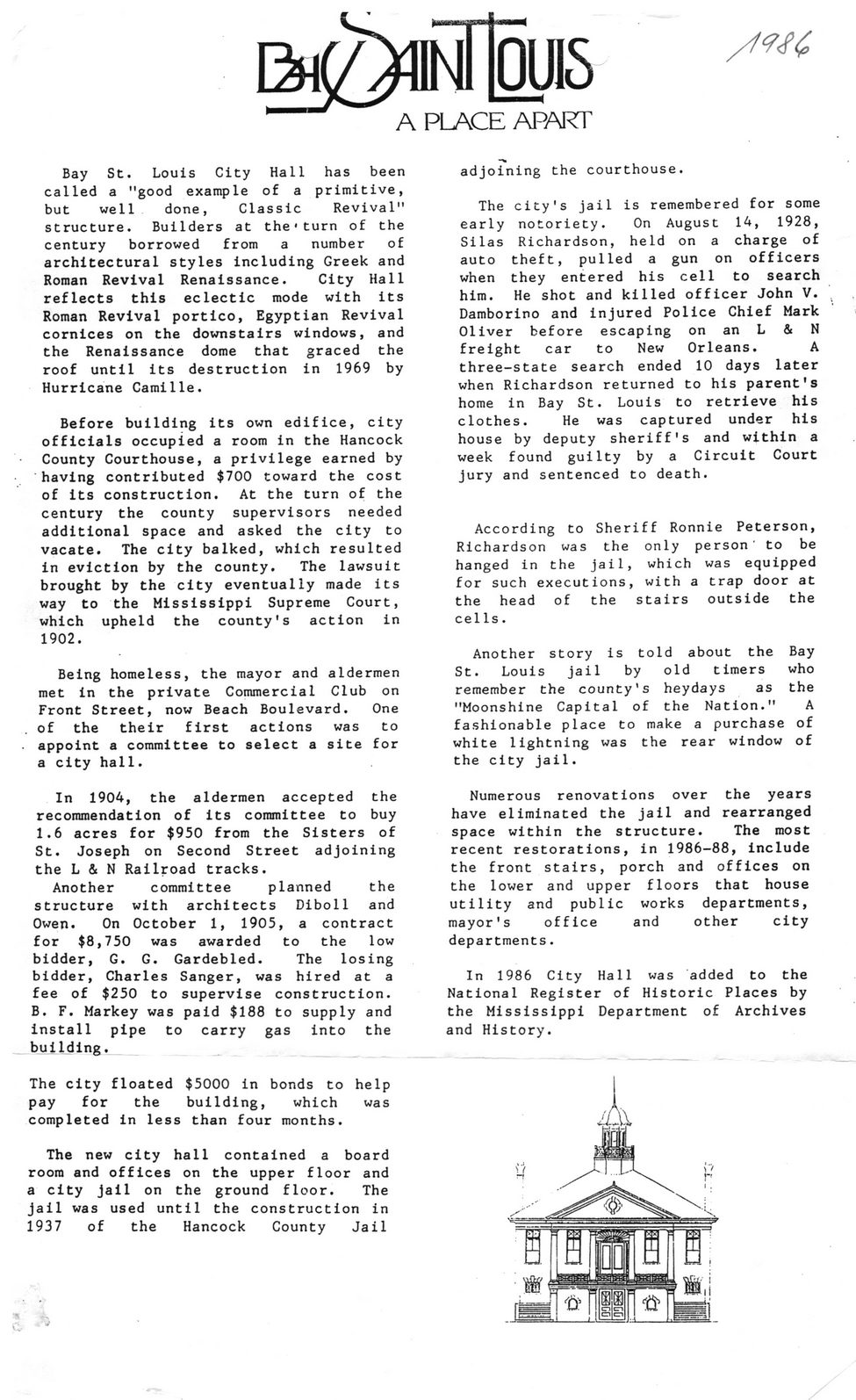This text was obtained via automated optical character recognition.
It has not been edited and may therefore contain several errors.
&j^iNfloyis A PLACE APART Bay St. Louis City Hall has been called a "good example of a primitive, but well done, Classic Revival" structure. Builders at the■turn of the century borrowed from a number of architectural styles including Greek and Roman Revival Renaissance. City Hall reflects this eclectic mode with its Roman Revival portico, Egyptian Revival cornices on the downstairs windows, and the Renaissance dome that graced the roof until its destruction in 1969 by Hurricane Camille. Before building its own edifice, city officials occupied a room in the Hancock County Courthouse, a privilege earned by having contributed $700 toward the cost of its construction. At the turn of the century the county supervisors needed additional space and asked the city to vacate. The city balked, which resulted in eviction by the county. The lawsuit brought by the city eventually made its way to the Mississippi Supreme Court, which upheld the county's action in 1902. Being homeless, the mayor and aldermen met in the private Commercial Club on Front Street, now Beach Boulevard. One . of the their first actions was to appoint a committee to select a site for a city hall. In 1904, the aldermen accepted the recommendation of its committee to buy 1.6 acres for $950 from the Sisters of St. Joseph on Second Street adjoining the L&N Railroad tracks. Another committee planned the structure with architects Diboll and Owen. On October 1, 1905, a contract for $8,750 was awarded to the low bidder, G. G. Gardebled. The losing bidder, Charles Sanger, was hired at a fee of $250 to supervise construction. B. F. Markey was paid $188 to supply and install pipe to carry gas into the building. The city floated $5000 in bonds to help pay for the building, which was completed in less than four months. The new city hall contained a board room and offices on the upper floor and a city jail on the ground floor. The jail was used until the construction in 1937 of the Hancock County Jail adjoining the courthouse. The city's jail is remembered for some early notoriety. On August 14, 1928, Silas Richardson, held on a charge of auto theft, pulled a gun on officers when they entered his cell to search him. He shot and killed officer John V. Damborino and injured Police Chief Mark Oliver before escaping on an L & N freight car to New Orleans. A three-state search ended 10 days later when Richardson returned to his parent's home in Bay St. Louis to retrieve his clothes. He was captured under his house by deputy sheriff's and within a week found guilty by a Circuit Court jury and sentenced to death. According to Sheriff Ronnie Peterson, Richardson was the only person' to be hanged in the jail, which was equipped for such executions, with a trap door at the head of the stairs outside the cel Is. Another story is told about the Bay St. Louis jail by old timers who remember the county's heydays as the "Moonshine Capital of the Nation." A fashionable place to make a purchase of white lightning was the rear window of the city jail. Numerous renovations over the years have eliminated the jail and rearranged space within the structure. The most recent restorations, in 1986-88, include the front stairs, porch and offices on the lower and upper floors that house utility and public works departments, mayor's office and other city departments. In 1986 City Hall was added to the National Register of Historic Places by the Mississippi Department of Archives and History.

BSL 1981 To 1990 City-Hall-Facelift-(1)